A GIS-Based Decision Support Model (DSM) for Harvesting System Selection on Steep Terrain: Integrating Operational and Silvicultural Criteria
Abstract
1. Introduction
2. Materials and Methods
2.1. Generating the GIS-Based Decision Support Model
2.2. Generation of the Six Layers for the Model
- (i)
- The first layer delineated the network of watercourses within the study area, based on available cartographic data.
- (ii)
- The second layer represented the forest road net. To address soil protection concerns, areas for ground-based logging were limited to a certain distance from forest roads. Areas beyond this distance were categorized as suitable for cable-based systems. This range was delineated using the GRASS GIS tool r.grow.distance.
- (iii)
- The third layer, representing slope, was calculated based on a Digital Terrain Model (DTM) at a spatial resolution of 2.5 m × 2.5 m.
- (iv)
- The fourth layer captured terrain ruggedness, a critical factor for ground-based extraction systems, calculated using the topographic ruggedness index (TRI) [28] within the SAGA GIS environment. The TRI measures the variability in elevation around a specific pixel by calculating the standard deviation of elevations of the neighboring pixels. Parameters were adjusted to reduce sensitivity to abrupt elevation changes, using a linear weighting function for the impact of the distance of pixels around a reference pixel, and a 12.5 m × 12.5 m calculation window was used to ensure a generalized terrain assessment.
- (v)
- The fifth layer assessed soil-bearing capacity. Since no detailed information on the soil type of the chosen study area was available, the Topographic Wetness Index (TWI), developed by Beven et al. [29], was used as a proxy for factors like precipitation, permeability, vegetation, and soil type. Specifically, it estimates the potential for soil moisture accumulation in the landscape and is calculated according to the following equation:where As is the upslope contributing area (m2/m), and β is the slope angle (radians).
- (vi)
- The sixth layer was on the distribution of Diameter at Breast Height (DBH) classes. This layer is essential for enabling silvicultural examinations. The process consisted of the following three main steps:
2.3. Model Implementation
2.4. Model Validation
2.5. Data
2.6. Test Area
3. Results
3.1. Layers Determining the Operational Site Conditions
3.2. The Layer Determining the Silvicultural Conditions (DBH Classes)
4. Discussion
4.1. Operational Predictions of the Model
4.2. Silvicultural Predictions of the Model
4.2.1. Setting up the DeepForest Algorithm
4.2.2. Generating the Map on Diameter Class Distribution
4.3. Model Limitations
4.4. Perspectives on the Model as a Decision Support Tool and Its Future Development
5. Conclusions
Author Contributions
Funding
Data Availability Statement
Conflicts of Interest
References
- Jordan, P.; Millard, T.H.; Campbell, D.; Schwab, J.W.; Wilford, D.J.; Nicol, D.; Collins, D. Forest management effects on hillslope processes. Compend. For. Hydrol. Geomorphol. Br. Columbia. BC Min. For. Range 2010, 66, 275. [Google Scholar]
- Visser, R.; Stampfer, K. Expanding ground-based harvesting onto steep terrain: A review. Croat. J. For. Eng. J. Theory Appl. For. Eng. 2015, 36, 321–331. [Google Scholar]
- Spinelli, R.; Cacot, E.; Mihelic, M.; Nestorovski, L.; Mederski, P.; Tolosana, E. Techniques and productivity of coppice harvesting operations in Europe: A meta-analysis of available data. Ann. For. Sci. 2016, 73, 1125–1139. [Google Scholar] [CrossRef]
- Holzfeind, T.; Visser, R.; Chung, W.; Holzleitner, F.; Erber, G. Development and Benefits of Winch-Assist Harvesting. Curr. For. Rep. 2020, 6, 201–209. [Google Scholar] [CrossRef]
- Schweier, J.; Ludowicy, C. Comparison of A Cable-Based and a Ground-Based System in Flat and Soil-Sensitive Area: A Case Study from Southern Baden in Germany. Forests 2020, 11, 611. [Google Scholar] [CrossRef]
- Bont, L.G.; Fraefel, M.; Frutig, F.; Holm, S.; Ginzler, C.; Fischer, C. Improving forest management by implementing best suitable timber harvesting methods. J. Environ. Manag. 2022, 302, 114099. [Google Scholar] [CrossRef]
- Erber, G.; Spinelli, R. Timber extraction by cable yarding on flat and wet terrain: A survey of cable yarder manufacturer’s experience. Silva Fenn. 2020, 54, 10211. [Google Scholar] [CrossRef]
- Sundberg, B.; Silversides, C.R. Operational Efficiency in Forestry: Vol. 1: Analysis. Vol. 29; Springer Science & Business Media: Berlin/Heidelberg, Germany, 1988. [Google Scholar] [CrossRef]
- Piragnolo, M.; Grigolato, S.; Pirotti, F. Planning harvesting operations in forest environment: Remote sensing for decision support. In ISPRS Annals of Photogrammetry, Remote Sensing and Spatial Information Sciences; Copernicus GmbH: Göttingen, Germany, 2019; pp. 33–40. [Google Scholar] [CrossRef]
- Mederski, P.S.; Werk, K.; Bembenek, M.; Karaszewski, Z.; Brunka, M.; Naparty, K. Harvester efficiency in trunk utilisation and log quality of early thinning pine trees. For. Res. Pap. 2019, 80, 45–53. [Google Scholar] [CrossRef][Green Version]
- Spinelli, R.; Magagnotti, N. Comparison of two harvesting systems for the production of forest biomass from the thinning of Picea abies plantations. Scand. J. For. Res. 2010, 25, 69–77. [Google Scholar] [CrossRef]
- Gan, Y.; Wang, Q.; Iio, A. Tree Crown Detection and Delineation in a Temperate Deciduous Forest from UAV RGB Imagery Using Deep Learning Approaches: Effects of Spatial Resolution and Species Characteristics. Remote Sens. 2023, 15, 778. [Google Scholar] [CrossRef]
- Fu, H.; Zhao, H.; Jiang, J.; Zhang, Y.; Liu, G.; Xiao, W.; Du, S.; Guo, W.; Liu, X. Automatic detection tree crown and height using Mask R-CNN based on unmanned aerial vehicles images for biomass mapping. For. Ecol. Manag. 2024, 555, 121712. [Google Scholar] [CrossRef]
- Zhang, C.; Zhou, J.; Wang, H.; Tan, T.; Cui, M.; Huang, Z.; Wang, P.; Zhang, L. Multi-Species Individual Tree Segmentation and Identification Based on Improved Mask R-CNN and UAV Imagery in Mixed Forests. Remote Sens. 2022, 14, 874. [Google Scholar] [CrossRef]
- Sivanandam, P.; Lucieer, A. Tree Detection and Species Classification in a Mixed Species Forest Using Unoccupied Aircraft System (UAS) RGB and Multispectral Imagery. Remote Sens. 2022, 14, 4963. [Google Scholar] [CrossRef]
- Persson, D. Tree Crown Detection Using Machine Learning: A Study on Using the DeepForest Deep-Learning Model for Tree Crown Detection in Drone-Captured Aerial Footage; KTH Royal Institute of Technology: Stockholm, Sweden, 2024. [Google Scholar]
- Wang, Z.; Li, P.; Cui, Y.; Lei, S.; Kang, Z. Automatic Detection of Individual Trees in Forests Based on Airborne LiDAR Data with a Tree Region-Based Convolutional Neural Network (RCNN). Remote Sens. 2023, 15, 1024. [Google Scholar] [CrossRef]
- Bennett, L.; Wilson, B.; Selland, S.; Qian, L.; Wood, M.; Zhao, H.; Boisvert, J. Image to attribute model for trees (ITAM-T): Individual tree detection and classification in Alberta boreal forest for wildland fire fuel characterization. Int. J. Remote Sens. 2022, 43, 1848–1880. [Google Scholar] [CrossRef]
- Freudenberg, M.; Schnell, S.; Magdon, P. A Sentinel-2 machine learning dataset for tree species classification in Germany. Earth Syst. Sci. Data Discuss. 2024, 2024, 1–20. [Google Scholar] [CrossRef]
- Beloiu, M.; Heinzmann, L.; Rehush, N.; Gessler, A.; Griess, V.C. Individual Tree-Crown Detection and Species Identification in Heterogeneous Forests Using Aerial RGB Imagery and Deep Learning. Remote Sens. 2023, 15, 1463. [Google Scholar] [CrossRef]
- Klosterhuber, R.; Plettenbacher, T. Vorrangige Holzernteverfahren auf der Technisch Nutzbaren Waldfläche in Südtirol und Ihre Tauglichkeit für Vollbaumnutzung; Report Commissioned by TIS Innovation Park; WLM Büro für Vegetationsökologie und Umweltplanung Klosterhuber & Partner OG: Bolzano, Italy, 2013. [Google Scholar]
- Phelps, K.; Hiesl, P.; Hagan, D.; Hagan, A.H. The Harvest Operability Index (HOI): A Decision Support Tool for Mechanized Timber Harvesting in Mountainous Terrain. Forests 2021, 12, 1307. [Google Scholar] [CrossRef]
- QGIS Development Team. QGIS Geographic Information System; Open Source Geospatial Foundation: Chicago, IL, USA, 2018; Available online: https://qgis.org (accessed on 15 October 2024).
- Conrad, O.; Bechtel, B.; Bock, M.; Dietrich, H.; Fischer, E.; Gerlitz, L.; Wehberg, J.; Wichmann, V.; Böhner, J. System for Automated Geoscientific Analyses (SAGA) v. 2.1.4. Geosci. Model Dev. 2015, 8, 1991–2007. [Google Scholar] [CrossRef]
- GRASS Development Team. Geographic Resources Analysis Support System (GRASS GIS) Software; v. 8; Open Source Geospatial Foundation: Beaverton, OR, USA, 2024; Available online: https://grass.osgeo.org (accessed on 15 October 2024).
- Visser, R.; Spinelli, R. Assessment of a Winch-Assisted Skidder in Castle Downs Forest, New Zealand; Rep H048 For Grow Res Ltd.: Rotorua, New Zealand, 2020. [Google Scholar]
- Engler, B.; Hartmann, G.; Mederski, P.S.; Bont, L.G.; Picchi, G.; Alcoverro, G.; Purfürst, T.; Schweier, J. Impact of Forest Operations in Four Biogeographical Regions in Europe: Finding the Key Drivers for Future Development. Curr. For. Rep. 2024, 10, 337–359. [Google Scholar] [CrossRef]
- Riley, S.J.; DeGloria, S.D.; Elliot, R. Index that quantifies topographic heterogeneity. Intermt. J. Sci. 1999, 5, 23–27. [Google Scholar]
- Beven, K.J.; Kirkby, M.J. A physically based, variable contributing area model of basin hydrology/Un modèle à base physique de zone d’appel variable de l’hydrologie du bassin versant. Hydrol. Sci. J. 1979, 24, 43–69. [Google Scholar] [CrossRef]
- Weinstein, B.G.; Marconi, S.; Aubry-Kientz, M.; Vincent, G.; Senyondo, H.; White, E.P. DeepForest: A Python package for RGB deep learning tree crown delineation. Methods Ecol. Evol. 2020, 11, 1743–1751. [Google Scholar] [CrossRef]
- Russell, B.C.; Torralba, A.; Murphy, K.P.; Freeman, W.T. LabelMe: A Database and Web-Based Tool for Image Annotation. Int. J. Comput. Vis. 2008, 77, 157–173. [Google Scholar] [CrossRef]
- Rijsbergen, V. Reviews: Van Rijsbergen, C.J. Information retrieval. 2nd edn. London, Butterworths, I978. 208pp. J. Librariansh. 1979, 11, 237. [Google Scholar] [CrossRef]
- Hasenauer, H. Dimensional relationships of open-grown trees in Austria. For. Ecol. Manag. 1997, 96, 197–206. [Google Scholar] [CrossRef]
- Jucker, T.; Caspersen, J.; Chave, J.; Antin, C.; Barbier, N.; Bongers, F.; Dalponte, M.; van Ewijk, K.Y.; Forrester, D.I.; Haeni, M.; et al. Allometric equations for integrating remote sensing imagery into forest monitoring programmes. Glob. Change Biol. 2017, 23, 177–190. [Google Scholar] [CrossRef]
- Pretzsch, H.; Biber, P.; Ďurský, J. The single tree-based stand simulator SILVA: Construction, application and evaluation. For. Ecol. Manag. 2002, 162, 3–21. [Google Scholar] [CrossRef]
- Gauthier, M.-M.; Tremblay, S. Precommercial thinning as a silvicultural option for treating very dense conifer stands. Scand. J. For. Res. 2018, 33, 446–454. [Google Scholar] [CrossRef]
- Simard, S.W.; Blenner-Hassett, T.; Cameron, I.R. Pre-commercial thinning effects on growth, yield and mortality in even-aged paper birch stands in British Columbia. For. Ecol. Manag. 2004, 190, 163–178. [Google Scholar] [CrossRef]
- Saari, V.; Peura, M.; Halme, P. Effects of changed interpretation of the Finnish Forest Act on the Riparian Woodland Key habitats. Scand. J. For. Res. 2024, 39, 377–391. [Google Scholar] [CrossRef]
- Marchi, E.; Picchio, R.; Spinelli, R.; Verani, S.; Venanzi, R.; Certini, G. Environmental impact assessment of different logging methods in pine forests thinning. Ecol. Eng. 2014, 70, 429–436. [Google Scholar] [CrossRef]
- Picchio, R.; Mederski, P.S.; Tavankar, F. How and How Much, Do Harvesting Activities Affect Forest Soil, Regeneration and Stands? Curr. For. Rep. 2020, 6, 115–128. [Google Scholar] [CrossRef]
- Leslie, C. Productivity and Utilisation of Winch-Assist Harvesting Systems: Case Studies in New Zealand and Canada. Master’s Thesis, University of Canterbury, Christchurch, New Zealand, 2019. [Google Scholar]
- Marchi, L.; Grigolato, S.; Mologni, O.; Scotta, R.; Cavalli, R.; Montecchio, L. State of the Art on the Use of Trees as Supports and Anchors in Forest Operations. Forests 2018, 9, 467. [Google Scholar] [CrossRef]
- Obi, F.; Visser, R. Benchmarking 2019 Data and Longer-Term Productivity and Cost Analyses; Technical Report; School of Forestry, University of Canterbury: Christchurch, New Zealand, 2020. [Google Scholar]
- Pourali, S.H.; Arrowsmith, C.; Chrisman, N.; Matkan, A.A.; Mitchell, D. Topography Wetness Index Application in Flood-Risk-Based Land Use Planning. Appl. Spat. Anal. Policy 2016, 9, 39–54. [Google Scholar] [CrossRef]
- Abetz, P. Eine Entscheidungshilfe für die Durchforstung von Fichtenbeständen. Allg Forstz. 1975, 30, 666–667. [Google Scholar]
- GRASS Development Team. r.mapcalc—GRASS GIS Manual. Available online: https://grass.osgeo.org/grass82/manuals/r.mapcalc.html (accessed on 15 October 2024).
- Anderson, T.W.; Darling, D.A. Asymptotic Theory of Certain “Goodness of Fit” Criteria Based on Stochastic Processes. Ann. Math. Stat. 1952, 23, 193–212. [Google Scholar] [CrossRef]
- James, G.; Witten, D.; Hastie, T.; Tibshirani, R. An Introduction to Statistical Learning; Springer: Berlin/Heidelberg, Germany, 2013; p. 9. [Google Scholar]
- South Tyrolean Citizen Network. Mapview Portal. Available online: https://mapview.civis.bz.it (accessed on 15 October 2024).
- Autonomous Province of Bolzano. Office for Meteorology and Avalanche Warning: Climate Data Portal. Available online: https://wetter.provinz.bz.it/download-messdaten.asp (accessed on 26 February 2025).
- Python Software Foundation. Python; Version 3.11.7; Python Software Foundation: Delaware, DE, USA, 2023; Available online: https://www.python.org (accessed on 15 October 2024).
- Hoffmann, S.; Schönauer, M.; Heppelmann, J.; Asikainen, A.; Cacot, E.; Eberhard, B.; Hasenauer, H.; Ivanovs, J.; Jaeger, D.; Lazdins, A.; et al. Trafficability Prediction Using Depth-to-Water Maps: The Status of Application in Northern and Central European Forestry. Curr. For. Rep. 2022, 8, 55–71. [Google Scholar] [CrossRef]
- Salmivaara, A.; Launiainen, S.; Perttunen, J.; Nevalainen, P.; Pohjankukka, J.; Ala-Ilomäki, J.; Sirén, M.; Laurén, A.; Tuominen, S.; Uusitalo, J.; et al. Towards dynamic forest trafficability prediction using open spatial data, hydrological modelling and sensor technology. For. Int. J. For. Res. 2020, 93, 662–674. [Google Scholar] [CrossRef]
- Cao, S. Soil rutting prediction using Random Forest model. For. Ecol. Manag. 2024, 558, 121361. [Google Scholar]
- Franklin, J.F.; Spies, T.A.; Van Pelt, R.; Carey, A.B.; Thornburgh, D.A.; Berg, D.R.; Lindenmayer, D.B.; Harmon, M.E.; Keeton, W.S.; Shaw, D.C.; et al. Disturbances and structural development of natural forest ecosystems with silvicultural implications, using Douglas-fir forests as an example. For. Ecol. Manag. 2002, 155, 399–423. [Google Scholar] [CrossRef]
- Fabris, S. Influence of Cambial Ageing, Initial Spacing, Stem Taper and Growth Rate on the Wood Quality of Three Coastal Conifers. Master’s Thesis, University of British Columbia, Vancouver, BC, Canada, 2000. [Google Scholar]
- Larson, B.C. Development and growth of even-aged stands of Douglas-fir and grand fir. Can. J. For. Res. 1986, 16, 367–372. [Google Scholar] [CrossRef]
- Begović, K.; Schurman, J.S.; Svitok, M.; Pavlin, J.; Langbehn, T.; Svobodová, K.; Mikoláš, M.; Janda, P.; Synek, M.; Marchand, W.; et al. Large old trees increase growth under shifting climatic constraints: Aligning tree longevity and individual growth dynamics in primary mountain spruce forests. Glob. Change Biol. 2023, 29, 143–164. [Google Scholar] [CrossRef]
- Hein, S.; Spiecker, H. 4.3 Controlling Diameter Growth of Common Ash, Sycamore and Wild Cherry. Valuab. Broadleaved For. Eur. 2009, 22, 123. [Google Scholar]
- Hastings, J.H.; Ollinger, S.V.; Ouimette, A.P.; Sanders-DeMott, R.; Palace, M.W.; Ducey, M.J.; Sullivan, F.B.; Basler, D.; Orwig, D.A. Tree Species Traits Determine the Success of LiDAR-Based Crown Mapping in a Mixed Temperate Forest. Remote Sens. 2020, 12, 309. [Google Scholar] [CrossRef]
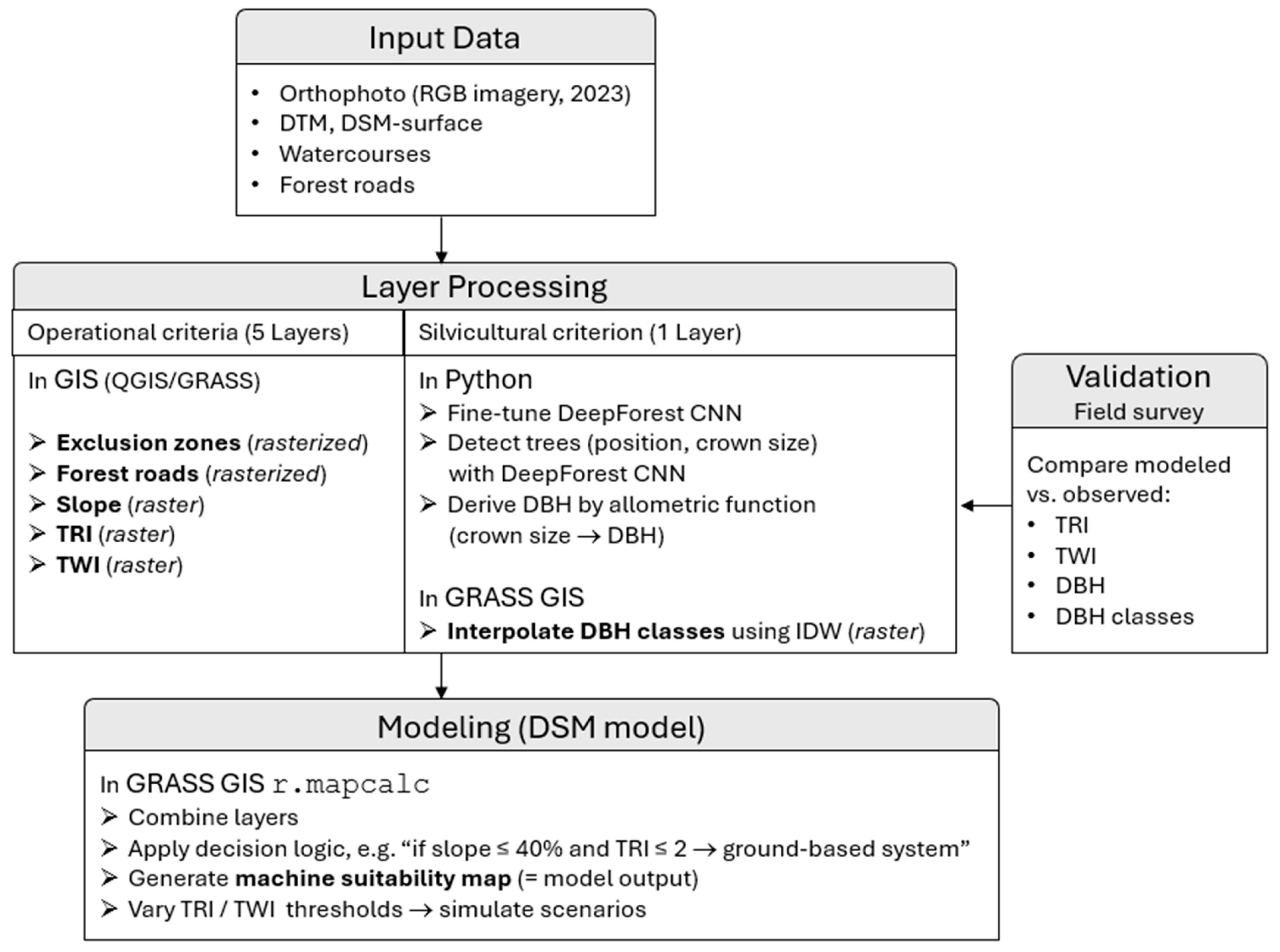
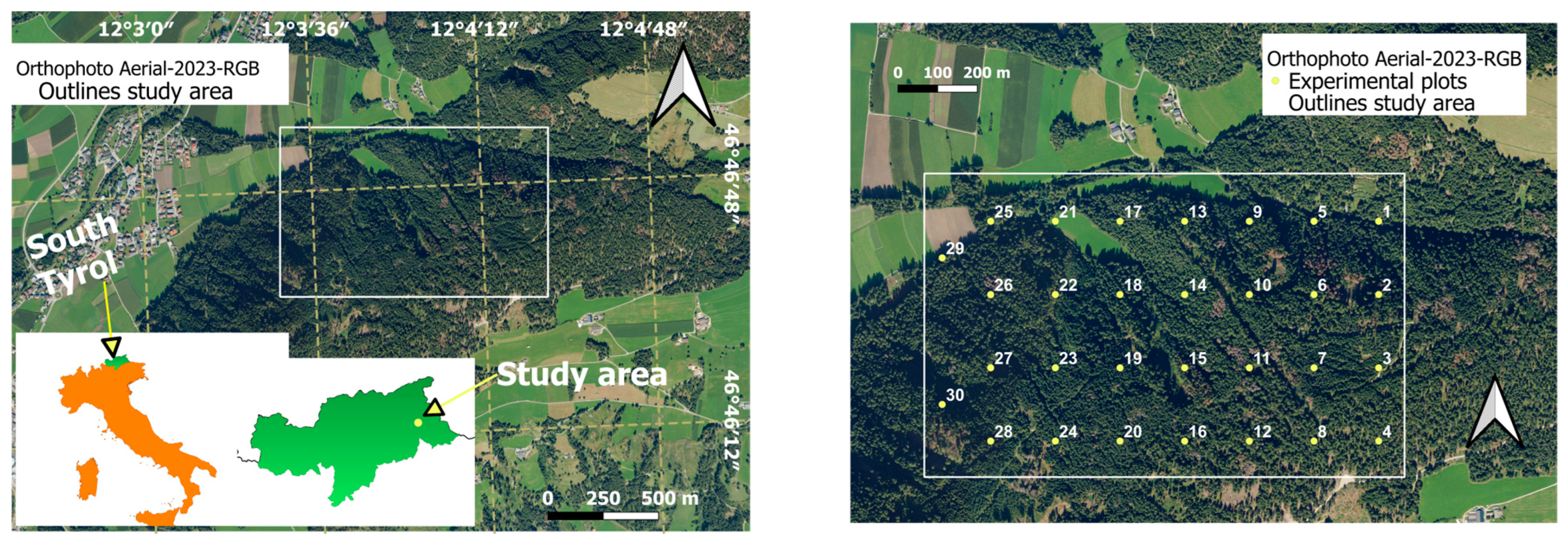
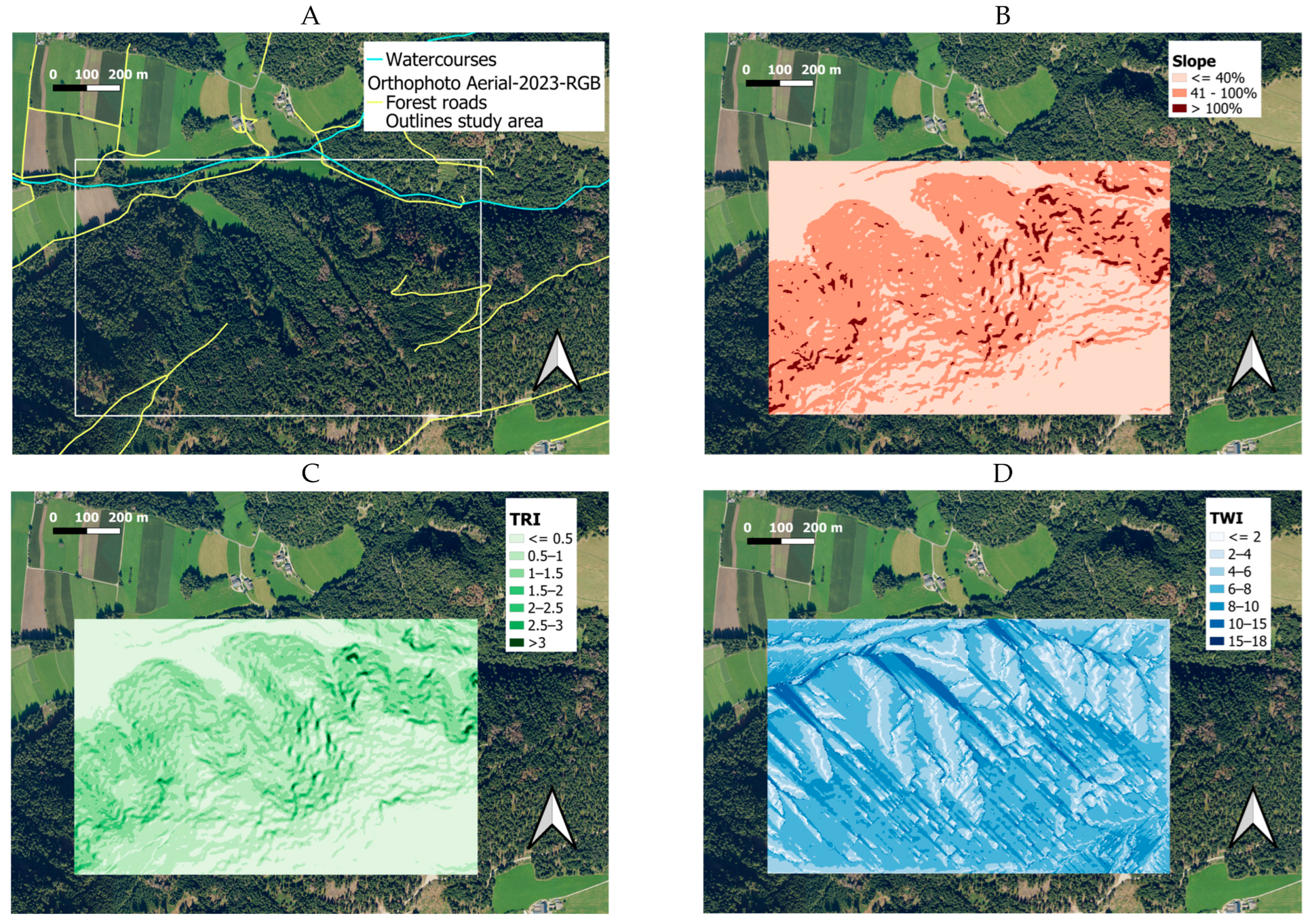
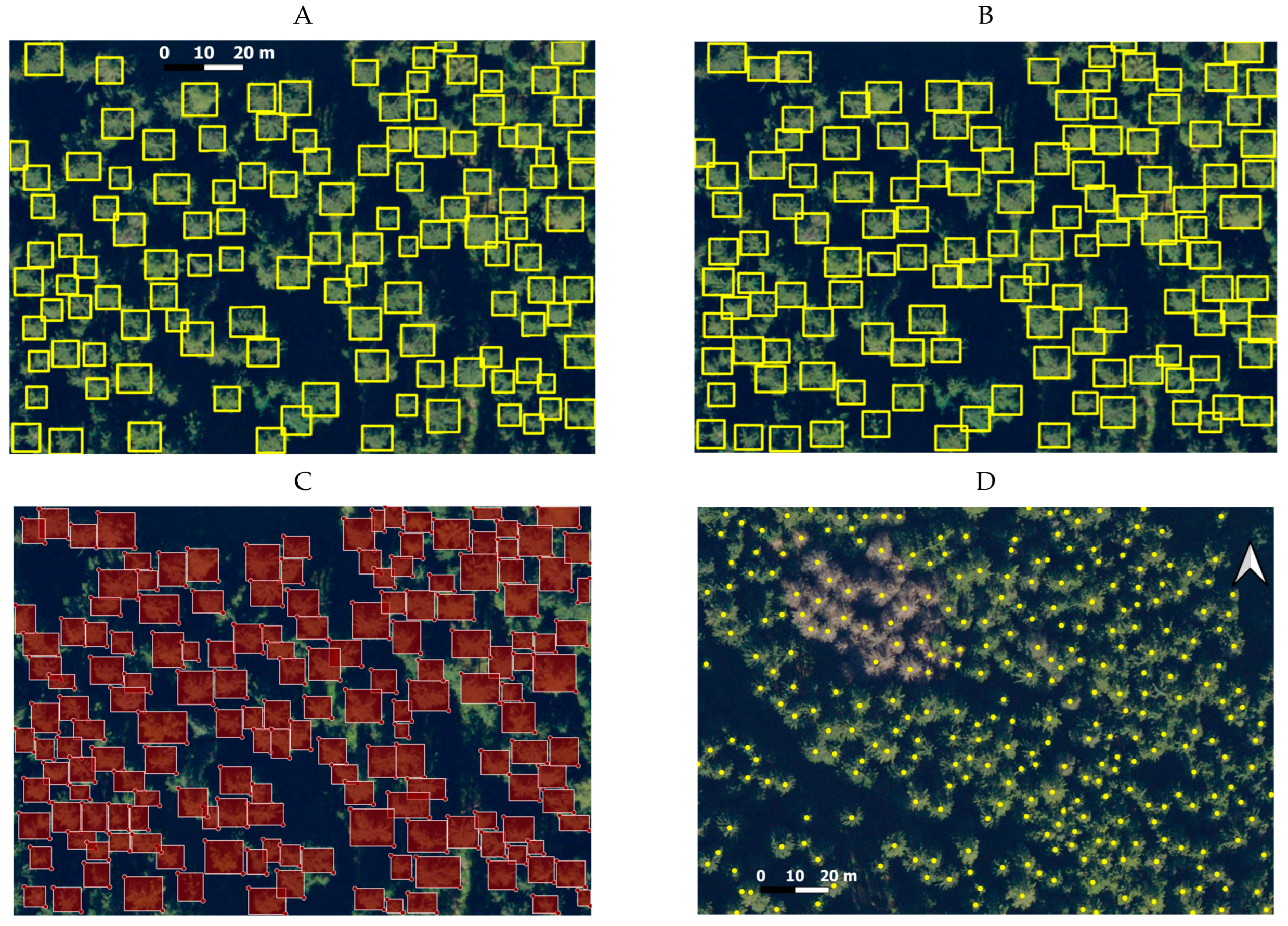
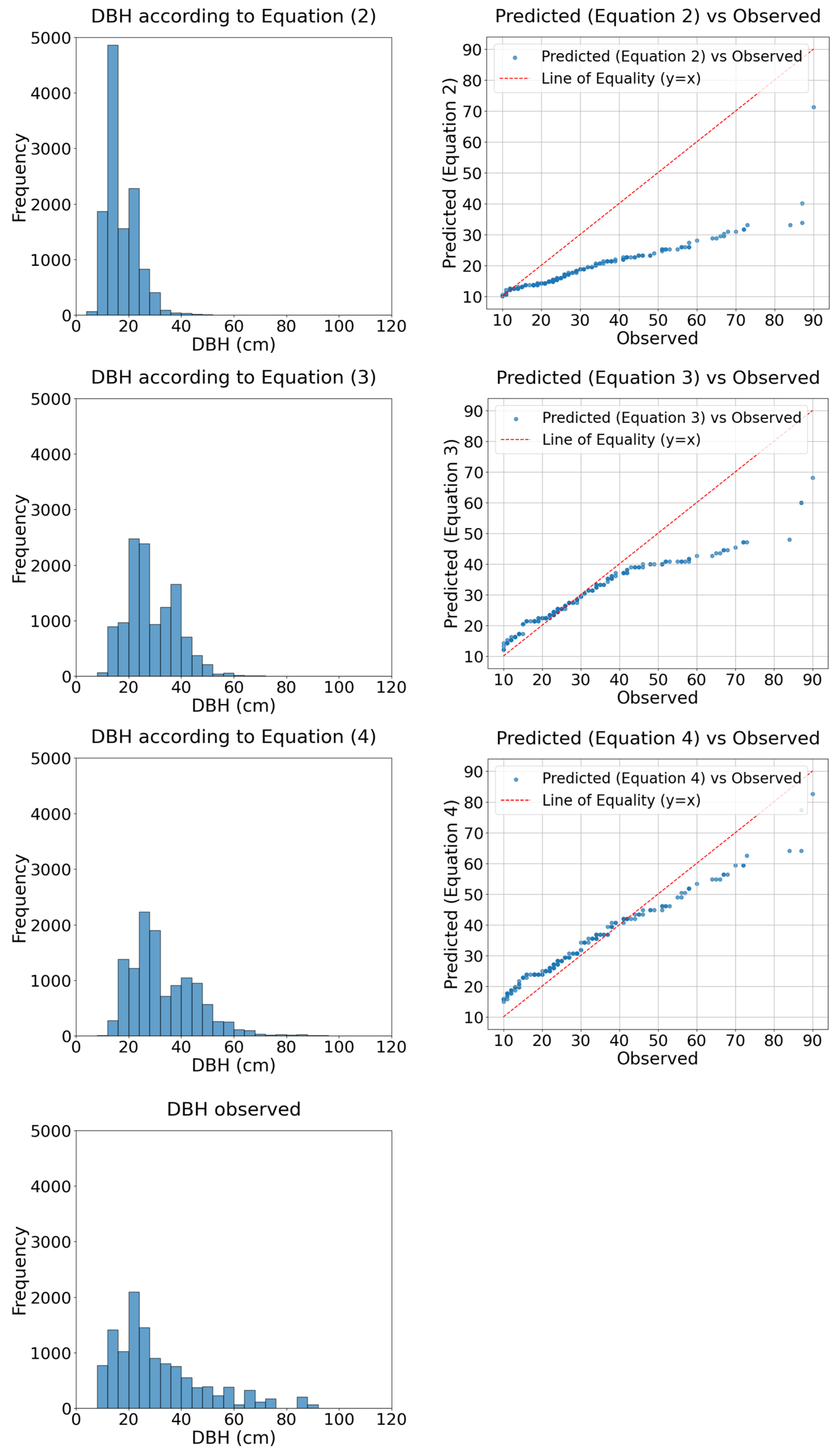

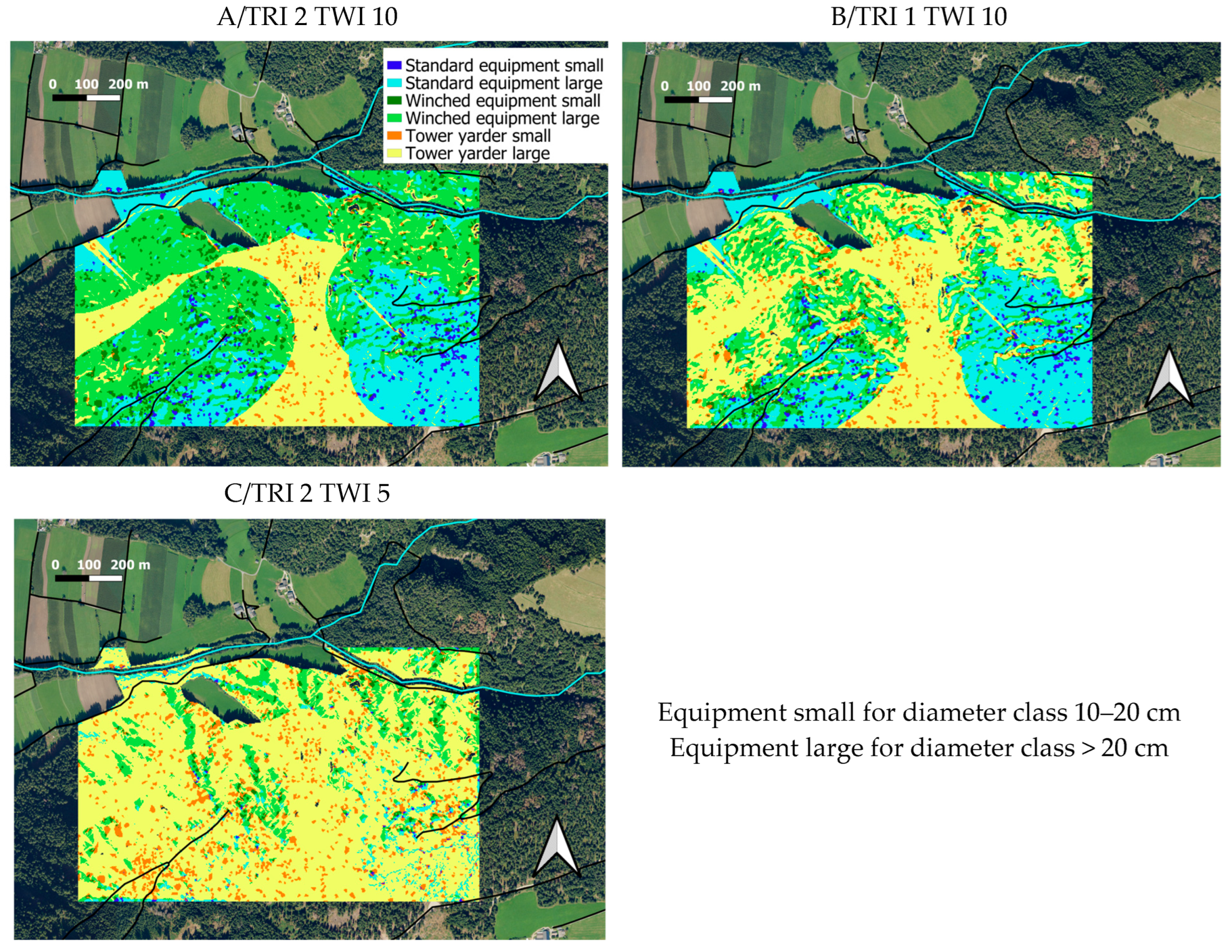
| Name of Layer | Type of Layer | Format | Resolution/Bands |
|---|---|---|---|
| Orthophoto image Aerial-2023-RGB | Raster | GeoTIFF | 2.5 m × 2.5 m 3 bands (RGB) |
| Digital Terrain Model South Tyrol | Raster | GeoTIFF | 2.5 m × 2.5 m 1 band (elevation) |
| Digital Surface Model South Tyrol | Raster | GeoTIFF | 2.5 m × 2.5 m 1 band (surface h) |
| Watercourses | Vector (Line) | ESRI Shape | Typology: Polyline |
| Road net | Vector (Line) | ESRI Shape | Typology: Polyline |
| Predicted | Ground Truth | ||
|---|---|---|---|
| Fine-tuning the model | Pre-trained | Fine-tuned | |
| Nr of trees as in Figure 4C | 118 | 122 | 166 |
| Precision | 0.899 | 0.913 | |
| Recall | 0.649 | 0.703 | |
| F1 | 0.752 | 0.794 | |
| Prediction performance | |||
| Nr of trees (observed per hectare) | 147 | 350 | |
| Precision | 1.00 | ||
| Recall | 0.429 | ||
| F1 | 0.600 | ||
| DBH (cm) | Height (m) | |||||
|---|---|---|---|---|---|---|
| Value | Equation (2) | Equation (3) | Equation (4) | Observed | CHM | Observed |
| Count | 12,472 | 12,472 | 12,472 | 196 | 12,472 | 28 |
| Mean | 17.097 | 28.608 | 33.245 | 31.929 | 22.479 | 24.565 |
| Std | 6.111 | 9.630 | 12.839 | 12.327 | 7.050 | 6.788 |
| Min | 6.019 | 7.407 | 10.789 | 14.975 | 5.376 | |
| 50% | 15.330 | 26.408 | 29.435 | 28.276 | 22.807 | 24.000 |
| Max | 76.221 | 89.981 | 164.657 | 95.310 | 49.203 | |
| DBH 10–20 | 130 (66%) | 31 (16%) | 27 (14%) | 56 (29%) | ||
| DBH 21–50 | 65 (33%) | 162 (82%) | 149 (76%) | 112 (57%) | ||
| DBH > 50 | 1 (1%) | 3 (2%) | 20 (10%) | 28 (14%) | ||
| R2 | 0.873 | 0.948 | 0.984 | |||
| AD | 0.001 | 0.001 | 0.001 | |||
| MAE | 12.426 | 4.784 | 4.566 | |||
| MBE | −12.381 | −2.318 | 1.742 | |||
| NRMSE | 0.207 | 0.102 | 0.069 | |||
| TRI Match Summary | TWI Match Summary | |||
|---|---|---|---|---|
| Model outcome | Count | Model outcome | Count | |
| Match | 26 | Match | 24 | |
| Mismatch | 2 | Mismatch | 4 | |
| DBH Class Confusion Matrix | ||||
| Observed | Predicted | |||
| Small | Medium | Large | ||
| Small | 3 | 1 | 0 | |
| Medium | 1 | 15 | 1 | |
| Large | 1 | 3 | 3 | |
| Scenario | St s | St l | Wi s | Wi l | Ty s | Ty l | No h | Total |
|---|---|---|---|---|---|---|---|---|
| TRI 2 TWI10 | 3 | 24 | 5 | 37 | 2 | 19 | 10 | 100 |
| TRI 1 TWI10 | 3 | 24 | 3 | 18 | 4 | 38 | 10 | 100 |
| TRI 2 TWI 5 | 1 | 3 | 1 | 9 | 8 | 68 | 10 | 100 |
Disclaimer/Publisher’s Note: The statements, opinions and data contained in all publications are solely those of the individual author(s) and contributor(s) and not of MDPI and/or the editor(s). MDPI and/or the editor(s) disclaim responsibility for any injury to people or property resulting from any ideas, methods, instructions or products referred to in the content. |
© 2025 by the authors. Licensee MDPI, Basel, Switzerland. This article is an open access article distributed under the terms and conditions of the Creative Commons Attribution (CC BY) license (https://creativecommons.org/licenses/by/4.0/).
Share and Cite
Eberhard, B.; Trailovic, Z.; Magagnotti, N.; Spinelli, R. A GIS-Based Decision Support Model (DSM) for Harvesting System Selection on Steep Terrain: Integrating Operational and Silvicultural Criteria. Forests 2025, 16, 854. https://doi.org/10.3390/f16050854
Eberhard B, Trailovic Z, Magagnotti N, Spinelli R. A GIS-Based Decision Support Model (DSM) for Harvesting System Selection on Steep Terrain: Integrating Operational and Silvicultural Criteria. Forests. 2025; 16(5):854. https://doi.org/10.3390/f16050854
Chicago/Turabian StyleEberhard, Benno, Zoran Trailovic, Natascia Magagnotti, and Raffaele Spinelli. 2025. "A GIS-Based Decision Support Model (DSM) for Harvesting System Selection on Steep Terrain: Integrating Operational and Silvicultural Criteria" Forests 16, no. 5: 854. https://doi.org/10.3390/f16050854
APA StyleEberhard, B., Trailovic, Z., Magagnotti, N., & Spinelli, R. (2025). A GIS-Based Decision Support Model (DSM) for Harvesting System Selection on Steep Terrain: Integrating Operational and Silvicultural Criteria. Forests, 16(5), 854. https://doi.org/10.3390/f16050854








